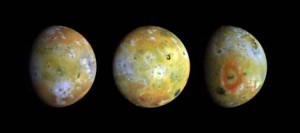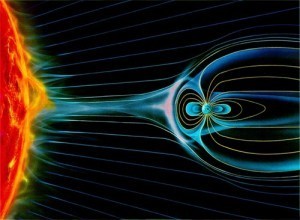Of all the moons in the solar system, ours is unique. It has surface composition similar to Earth’s, pointing to a common origin, and it’s unusually large to be orbiting such a small planet. Just how such a large moon came to orbit Earth remains a bit of a mystery. With a similar composition to Earth, it couldn’t have been captured by Earth’s gravity, and the Earth and Moon didn’t likely form at the same time from the primordial gas and dust of the solar system. So the dominant theory is that of a single large impact. Early in its history, Earth was struck by a Mars-sized object, sometimes called Theia. A combination of material from Earth and Theia coalesced to form the Moon.
While the impact model has a lot going for it, getting the Moon to form in a relatively close and roughly circular orbit requires just the right kind of collision. The best fit is a collision that was a fast, glancing impact at an odd angle. It’s not impossible, but such a collision between two large bodies would be extremely rare, even in the early solar system. So it’s worth wondering if there is another, more likely impact scenario. A new paper in Nature Geoscience argues that there is.
In this new model, our Moon wasn’t formed by a single impact, but by multiple impacts over time. Each impact would have created a ring of material around Earth, which collapsed into one or a few larger moons over time. Multiple impacts would have created multiple moons over the ages. If this is really what happened, why do we have just one moon instead of several? The key is the long term tidal effects on these moons.
Currently tidal forces between the Earth and Moon gradually slow down the Earth’s rotation, while simultaneously causing the Moon to drift ever farther from the Earth. The same effect would occur with multiple moons, causing them to move slightly away from Earth over time. But the closer a moon is to Earth, the stronger the tidal forces and the faster its orbital distance would increase. So if Earth’s multiple moons formed with roughly similar orbits, the orbits of the inner moons would drift outward until they collided with outer moons, eventually forming the single Moon we see today.
Computer simulations run by the team show that a multiple collision, multiple moon model could have created our single large Moon. The real question is whether that’s actually what happened. That really comes down to which is more likely, a single unusual large impact, or multiple large impacts over time. The jury’s still out on that one. But this new paper does show that there is more than one way to form a large moon around a small, rocky planet like ours.
Paper: Raluca Rufu,et al. A multiple-impact origin for the Moon. Nature Geoscience doi:10.1038/ngeo2866 (2017)












Comments
Dr. Kobrtlein, should this sentence “it could have been captured by Earth’s gravity” read “it could not have been captured by Earth’s gravity”?
.elver
Yep. I’ve corrected it, thanks.
One would think that if the building blocks of the moon came from rings of dust and rock around Earth that there would be some remnant of those rings still orbiting Earth. Maybe those remnants are out there to be discovered.